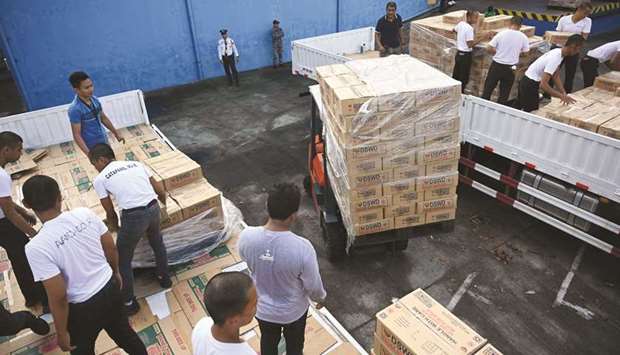Residents in areas battered by a series of strong earthquakes in the southern Philippines were yesterday told not to return to their homes yet as more tremors were expected to occur in the coming days.
At least 16 people were killed and 403 injured in the two quakes that struck the southern region of Mindanao on October 29 and 31, displacing more than 30,000 residents, the national disaster relief office said.
Hundreds of aftershocks have jolted the areas since then, and more than 3,200 houses, schools, health facilities, and private and commercial establishments were damaged, the office added.
Some structures have collapsed from the quakes.
“People are not allowed to go back to buildings,” said Mark Timbal, spokesman for the national disaster relief office. “What we’re trying to avoid at this time is the occurrence wherein there are people in the structure and another earthquake hits and the building collapses on them.”
“What is essential here is we keep our people safe even though they are forced to stay in open spaces, but we do not limit them from going to other places or their relatives so that they can find other places to stay, but not inside the area,” he added.
The October 29 quake had a magnitude of 6.6, while the October 31 tremor was measured at 6.5, the Philippine Institute of Volcanology and Seismology (Phivolcs) said.
On October 16, a 6.3-magnitude earthquake also struck the same area, killing seven people.
The epicentres for the three quakes were near Tulunan in Cotabato province, 972 kilometres south of Manila, the Philippine Institute of Volcanology and Seismology (Phivolcs) said.
Yesterday, Phivolcs said it has recorded more than 100 aftershocks or earthquakes, with the strongest measured at a magnitude of 5.5-magnitude near Sarangani town in Davao Occidental province.
The social welfare department was distributing tents, laminated sacks, hygiene kits, plastic bottles, water containers and food packs to the affected residents, said spokeswoman Irene Dumlao.
Social workers were also offering psycho-social counselling to help residents cope with the trauma.
“Our social workers who are deployed in the field are actually doing assessment of their cases so that we could determine appropriate interventions to be given to them,” Dumlao said.
The Philippines is located on the Pacific Ring of Fire, where about 90% of the world’s earthquakes take place.
The last major quake to hit the country was a 7.1-magnitude event that killed more than 220 people in the central Philippines in October 2013.
In July 1990, more than 2,400 people were killed on the northern island of Luzon in a 7.8-magnitude quake, one of the strongest ever to hit the country.

Coast guard personnel load food packs onto a truck destined for victims of recent earthquakes on Mindanao island in the southern Philippines, at a welfare warehouse in Manila, yesterday.
